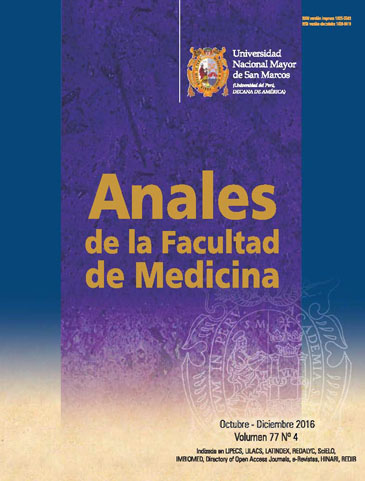Overcrowding in the adult emergency service of a tertiary hospital in Lima, Peru
DOI:
https://doi.org/10.15381/anales.v77i4.12654Keywords:
Emergency Service, Adults, Medical Care.Abstract
Objective. To determine the demand for medical care in the last decade. Design. Retrospective study. Participants. Patients aged 14 years or more attended at the Emergency Service of a tertiary hospital. Interventions. The institutional system was reviewed and analyzed with SPSS 21.0. Main outcome measures. Number of patients, demand profile, time slot, day and month of visit, destination, emergency room stay, and mortality. Results. 164 370 attentions were recorded during 2015, the patient’s average age was 57 years (SD 20), female 57.5%, came preferably in the morning, most often in laboring days (Monday), with a similar frequency every month, which declined in national holidays and Christmas. The daily average of attended, admitted and overnight staying patients in observation rooms increased respectively in 49%, 8%, and 78% in the last decade; the average of overnight patients decreased in the past two years. The initial attention area was: Medicine 36%, Surgery 21%, Traumatology 14 %, Nephrology 7%, Alleviation 18%, and Shock-Trauma unit 4%. 63% were discharged and mortality was 0.8%. The most frequent reasons for admission were poorly defined signs (abdominal pain, headache and fever), genitourinary problems and minor trauma. 22 883 were admitted to the emergency room, average age 65 years (SD 19), 58% were 65 years or older, 50.3% male, more frequent on Tuesdays and less on Sundays, stay between 8 and 11 hours. The most frequent diagnoses were respiratory failure, cerebrovascular disease, and sepsis. The overall average length of stay was 70 hours. Conclusions. The Adult Emergency Service of the biggest hospital in Peru presents an important excess demand for medical attention.Downloads
Published
2016-12-16
Issue
Section
Artículo Original
License
Copyright (c) 2016 Rolando Vásquez Alva

This work is licensed under a Creative Commons Attribution-NonCommercial-ShareAlike 4.0 International License.
Those authors who have publications with this magazine accept the following terms:
- Authors will retain their copyrights and guarantee the journal the right of first publication of their work, which will be simultaneously subject to Creative Commons Attribution License that allows third parties to share the work as long as its author and its first publication this magazine are indicated.
- Authors may adopt other non-exclusive licensing agreements for the distribution of the version of the published work (eg, deposit it in an institutional electronic file or publish it in a monographic volume) provided that the initial publication in this magazine is indicated.
- Authors are allowed and recommended to disseminate their work over the Internet (eg: in institutional telematic archives or on their website) before and during the submission process, which It can produce interesting exchanges and increase quotes from the published work. (See El efecto del acceso abierto ).
How to Cite
1.
Vásquez Alva R, Amado Tineo J, Ramírez Calderón F, Velásquez Velásquez R, Huari Pastrana R. Overcrowding in the adult emergency service of a tertiary hospital in Lima, Peru. An Fac med [Internet]. 2016 Dec. 16 [cited 2024 Jun. 30];77(4):379-85. Available from: https://revistasinvestigacion.unmsm.edu.pe/index.php/anales/article/view/12654















